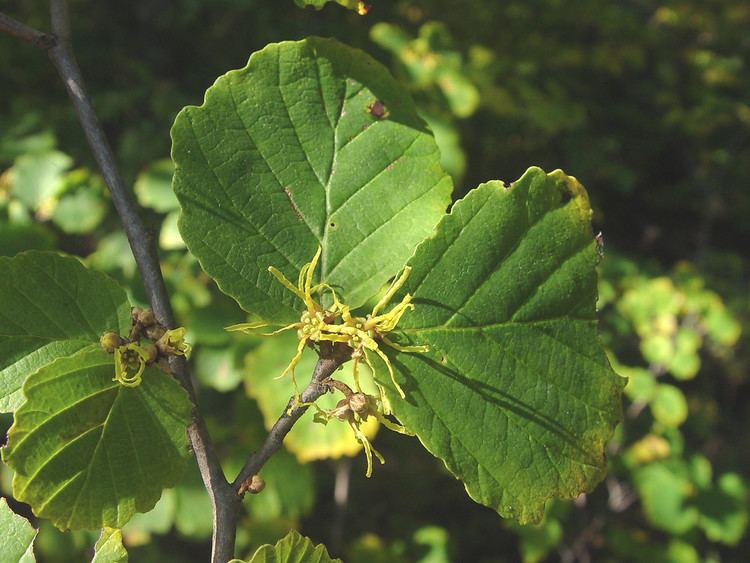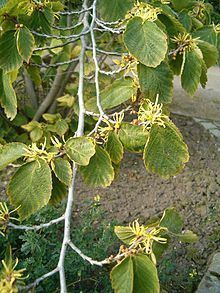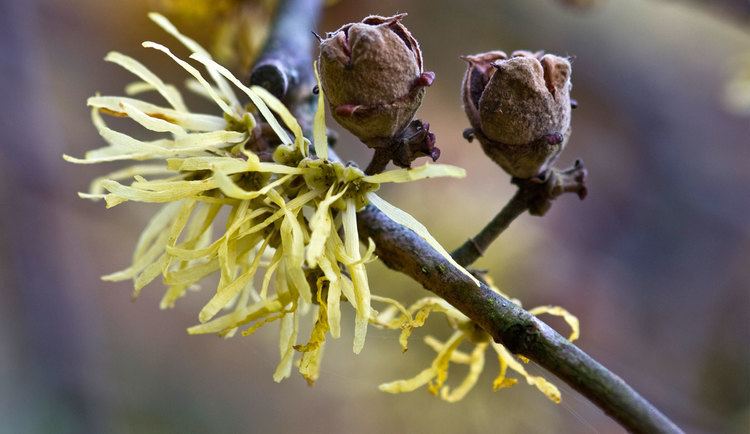Scientific name Hamamelis virginiana Rank Species | Genus Hamamelis Higher classification Witch-hazel | |
 | ||
Similar European horse‑chestnut, English marigold, Mountain arnica, Buckeyes, Centella asiatica | ||
Common witch hazel hamamelis virginiana how to grow witch hazel
Hamamelis virginiana, known as common or American witch-hazel, is a species of witch-hazel native to eastern North America, from Nova Scotia west to Minnesota, and south to central Florida to eastern Texas.
Contents

It is a small, deciduous tree growing up to 6 m (rarely to 10 m) tall, often with a dense cluster of stems from its base. The bark is light brown, smooth, scaly, inner bark reddish purple. The branchlets are pubescent at first, later smooth, light orange brown, marked with occasional white dots, finally dark or reddish brown. The foliage buds are acute, slightly falcate, downy, light brown. The leaves are oval, 3.7–16.7 cm long and 2.5–13 cm broad, oblique at the base, acute or rounded at the apex, with a wavy-toothed or shallowly lobed margin, and a short, stout petiole 6–15 mm long; the midrib is more or less hairy, stout, with six to seven pairs of primary veins. The young leaves open involute, covered with stellate rusty down; when full grown, they are dark green above, and paler beneath. In fall, they turn yellow with rusty spots. The leaf stipules are lanceolate, acute; they fall soon after the leaf expands.

The flowers are pale to bright yellow, rarely orange or reddish, with four ribbon-shaped petals 10–20 mm long and four short stamens, and grow in clusters; flowering begins in about mid-fall and continues until late fall. The flower calyx is deeply four-parted, very downy, orange brown within, imbricate in bud, persistent, cohering with the base of the ovary. Two or three bractlets appear at base. The fruit is a hard woody capsule 10–14 mm long, which splits explosively at the apex at maturity one year after pollination, ejecting the two shiny black seeds up to 10 m distant from the parent plant. It can be distinguished from the related Hamamelis vernalis by its flowering in fall, not winter.

Hamamelis virginiana
Uses
Native Americans produced witch hazel extract by boiling the stems of the shrub and producing a decoction, which was used to treat swellings, inflammations, and tumors. Early Puritan settlers in New England adopted this remedy from the natives, and its use became widely established in the United States.
An extract of the plant is used in the astringent witch hazel.

H. virginiana produces a specific kind of tannins called hamamelitannins. One of those substances displays a specific cytotoxic activity against colon cancer cells.
The bark and leaves were used by Native Americans in the treatment of external inflammations. Pond's Extract was a popular distillation of the bark in dilute alcohol.
The wood is light reddish brown, sapwood nearly white; heavy, hard, close-grained, with a density of 0.68.
The forked twigs of witch-hazel are preferred as divining rods.
